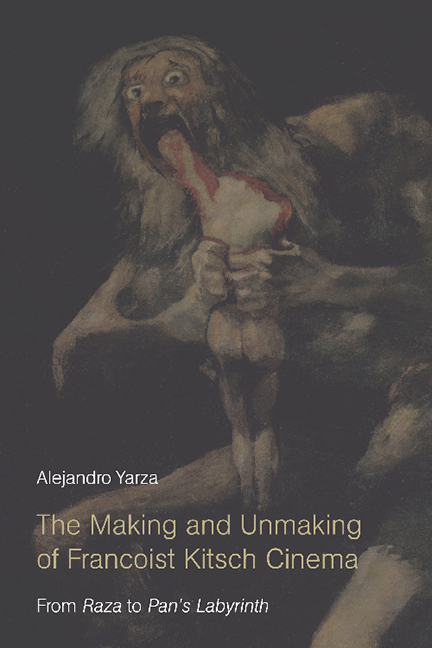Book contents
- Frontmatter
- Contents
- List of Figures
- Acknowledgments
- Preface
- Introduction
- 1 The Petrified Tears of General Franco: Kitsch and Fascism in José Luis Sáenz de Heredia’s Raza
- 2 Romancero Marroquí and the Francoist Kitsch Politics of Time
- 3 Los últimos de Filipinas: The Spatio-temporal Coordinates of Francoism
- 4 Surcos: Neorealism, Film Noir, and the Puppet Master
- 5 Franco, Ese Hombre: From Kitsch-Artist to Kitsch-Man
- 6 Viridiana: The World, the Flesh, and the Devil
- 7 Balada Triste De Trompeta: Of Ghosts and Clowns
- 8 Under the Sign of Saturn: The Labyrinth of Moral Choices in Francoist Spain
- Works Cited
- Index
8 - Under the Sign of Saturn: The Labyrinth of Moral Choices in Francoist Spain
Published online by Cambridge University Press: 10 November 2020
- Frontmatter
- Contents
- List of Figures
- Acknowledgments
- Preface
- Introduction
- 1 The Petrified Tears of General Franco: Kitsch and Fascism in José Luis Sáenz de Heredia’s Raza
- 2 Romancero Marroquí and the Francoist Kitsch Politics of Time
- 3 Los últimos de Filipinas: The Spatio-temporal Coordinates of Francoism
- 4 Surcos: Neorealism, Film Noir, and the Puppet Master
- 5 Franco, Ese Hombre: From Kitsch-Artist to Kitsch-Man
- 6 Viridiana: The World, the Flesh, and the Devil
- 7 Balada Triste De Trompeta: Of Ghosts and Clowns
- 8 Under the Sign of Saturn: The Labyrinth of Moral Choices in Francoist Spain
- Works Cited
- Index
Summary
The true fairy tale must be at once a prophetic representation—an ideal representation— an absolutely necessary representation. The maker of true fairy tales is a prophet of the future
—Novalis, Philosophical WritingsAccording to internationally renowned Mexican filmmaker Guillermo del Toro, Pan's Labyrinth (2006) is a film about “disobedience, choice and memory” (Diestro-Dópido 84). His critically acclaimed film is set in Spain in 1944 in the midst of brutal Francoist post-Civil War repression. The film upends Francoist kitsch ideology and symbolically ends the Francoist melancholic repressive cycle, delineated in the first part of this study, by rescuing Captain Vidal's newborn baby son from his fascist grip. Through the eyes of Ofelia, the film's young protagonist, we experience the intricate labyrinth of moral choices that citizens faced in Francoist Spain. Although many critics have argued that the supernatural events that take place in the film are a figment of the imagination of a dying child, I will try to show—in agreement with the filmmaker himself—that they are real occurrences. The film, I argue, is in fact a fairy tale for adults through which we are invited to confront our own moral responsibility in the proper mourning of a traumatic past.
Enhancing its emotional appeal through its fairy-tale narrative mode, Pan's Labyrinth revisits one of the bleakest periods of Spanish history to establish an emotional connection with contemporary spectators by inviting them to identify with its vulnerable child protagonist. Through this emotional identification with the travails of Ofelia in fascist Spain, the audience gets to relive their traumatic experiences while, through the fairy-tale “structures of wonder and magic” (Warner 74), ironically envisioning a future grounded in historical fact and not turned into a kitsch myth. Through a reading of the film's melancholic temporality, I hope to show how the film moves its spectators to work through the trauma of the nation's troubled past. It is my argument that it can only do this through the fairy-tale form, whose magic is, ironically, all that remains to oppressed peoples struggling to see through the spell of fascism to a vision of moral clarity.
- Type
- Chapter
- Information
- The Making and Unmaking of Francoist Kitsch CinemaFrom Raza to Pan's Labyrinth, pp. 261 - 292Publisher: Edinburgh University PressPrint publication year: 2017



